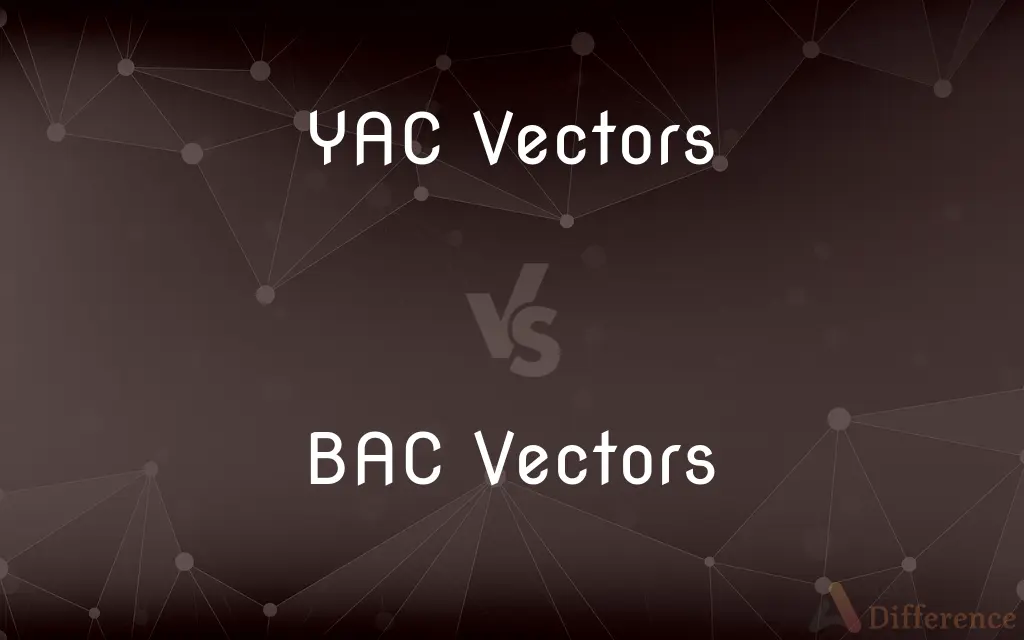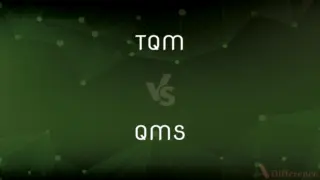YAC Vectors vs. BAC Vectors — What's the Difference?
By Tayyaba Rehman — Published on January 13, 2024
YAC Vectors are yeast artificial chromosomes used to clone large DNA fragments, while BAC Vectors are bacterial artificial chromosomes used for the same purpose in bacteria.

Difference Between YAC Vectors and BAC Vectors
Table of Contents
ADVERTISEMENT
Key Differences
YAC Vectors and BAC Vectors are both vital tools in genetic research, assisting in the cloning and analysis of large DNA segments. The primary distinction between the two lies in their origins and applications.
YAC Vectors, derived from yeast cells, have the unique ability to accommodate large DNA fragments, sometimes up to several megabases in length. On the other hand, BAC Vectors, originating from bacteria, can typically hold DNA fragments of 100-300 kilobases.
The reliability of YAC Vectors has been under scrutiny due to potential for chimerism and instability. Conversely, BAC Vectors, being bacterial in nature, offer more stability, making them a favored choice for many genetic mapping projects.
Both YAC Vectors and BAC Vectors have been pivotal in the Human Genome Project. While YACs initially played a more significant role due to their larger capacity, BACs' stability and ease of manipulation made them a preferable choice as the project evolved.
Despite the differences between YAC Vectors and BAC Vectors, both remain indispensable in genomic research, each offering unique advantages based on the specific requirements of the project at hand.
ADVERTISEMENT
Comparison Chart
Origin
Yeast cells
Bacteria
DNA Capacity
Large fragments (up to several megabases)
Typically 100-300 kilobases
Stability
Can be unstable and prone to chimerism
More stable and reliable
Use in Human Genome Project
Initially preferred due to larger capacity
Favored later due to stability
Complexity of Manipulation
More complex
Easier to manipulate
Compare with Definitions
YAC Vectors
YAC Vectors can house vast DNA sequences.
Some genetic sequences, too long for other vectors, fit perfectly into YAC Vectors.
BAC Vectors
BAC Vectors are derived from a specific plasmid in bacteria.
BAC Vectors are often used in genomics due to their stable nature.
YAC Vectors
YAC Vectors can be prone to instability.
Researchers often double-check results from YAC Vectors due to potential inconsistencies.
BAC Vectors
BAC Vectors have been crucial in genome mapping.
Many genome sequencing endeavors have been successful thanks to the reliability of BAC Vectors.
YAC Vectors
YAC Vectors played a role in early genome sequencing projects.
During the initial stages of the Human Genome Project, YAC Vectors were invaluable.
BAC Vectors
BAC Vectors allow for easier manipulation in the lab.
Geneticists often opt for BAC Vectors due to their user-friendly nature in experimental setups.
YAC Vectors
YAC Vectors have telomeres, centromeres, and replication origins.
The presence of these essential elements allows YAC Vectors to replicate within yeast cells.
BAC Vectors
BAC Vectors offer stability in replication.
Researchers prefer BAC Vectors when they need consistent and reliable cloning.
YAC Vectors
YAC Vectors are cloning vehicles derived from yeast chromosomes.
To clone an extensive DNA fragment, researchers might opt for YAC Vectors.
BAC Vectors
BAC Vectors can accommodate large DNA fragments.
For most genomic projects, BAC Vectors provide sufficient capacity to house large DNA sequences.
Common Curiosities
How do BAC Vectors differ from YAC Vectors?
BAC Vectors are bacterial artificial chromosomes with a different capacity and stability compared to YAC Vectors.
What are YAC Vectors?
They are yeast artificial chromosomes used for cloning large DNA fragments.
Are BAC Vectors more stable than YAC Vectors?
Yes, BAC Vectors generally offer more stability and less susceptibility to chimerism than YAC Vectors.
Are BAC Vectors derived from yeast?
No, BAC Vectors are derived from bacteria, whereas YAC Vectors come from yeast.
Which vector can hold larger DNA sequences?
YAC Vectors can typically accommodate larger DNA sequences compared to BAC Vectors.
Is it easy to manipulate BAC Vectors in a lab setting?
Yes, BAC Vectors are generally easier to handle and manipulate than YAC Vectors.
Which vector is more suitable for large genome projects?
While both have their merits, BAC Vectors are often favored due to their stability and ease of manipulation.
Why were YAC Vectors used in the Human Genome Project?
Their ability to hold large DNA fragments made them initially valuable, though BAC Vectors became more dominant later due to stability.
What are the limitations of YAC Vectors?
They can be unstable and are prone to chimerism, which can result in inaccurate cloning.
Can YAC Vectors be used in bacteria?
No, YAC Vectors are specific to yeast cells.
How are YAC Vectors constructed?
They are constructed using essential elements like telomeres, centromeres, and replication origins from yeast.
What is the primary application of BAC Vectors and YAC Vectors?
Both are primarily used in genetic research for cloning and analyzing large DNA fragments.
What is the origin of BAC Vectors?
BAC Vectors are derived from the F-plasmid found in bacteria.
Why is stability a concern with YAC Vectors?
Due to their structure and method of replication, YAC Vectors can sometimes rearrange or lose inserted DNA.
Can BAC Vectors be used in yeast?
Typically, no. BAC Vectors are designed for use in bacterial cells.
Share Your Discovery

Previous Comparison
TQM vs. QMS
Next Comparison
Tcpdump vs. WiresharkAuthor Spotlight
Written by
Tayyaba RehmanTayyaba Rehman is a distinguished writer, currently serving as a primary contributor to askdifference.com. As a researcher in semantics and etymology, Tayyaba's passion for the complexity of languages and their distinctions has found a perfect home on the platform. Tayyaba delves into the intricacies of language, distinguishing between commonly confused words and phrases, thereby providing clarity for readers worldwide.
















































